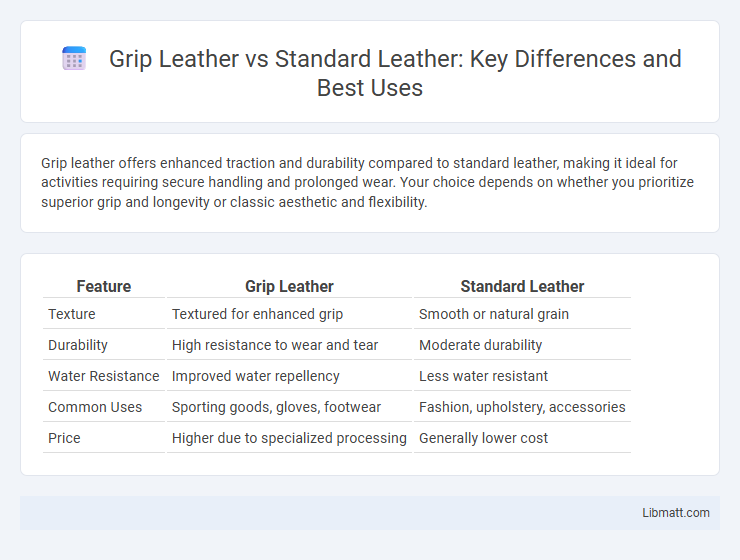Grip leather offers enhanced traction and durability compared to standard leather, making it ideal for activities requiring secure handling and prolonged wear. Your choice depends on whether you prioritize superior grip and longevity or classic aesthetic and flexibility.
Table of Comparison
| Feature | Grip Leather | Standard Leather |
|---|---|---|
| Texture | Textured for enhanced grip | Smooth or natural grain |
| Durability | High resistance to wear and tear | Moderate durability |
| Water Resistance | Improved water repellency | Less water resistant |
| Common Uses | Sporting goods, gloves, footwear | Fashion, upholstery, accessories |
| Price | Higher due to specialized processing | Generally lower cost |
Introduction to Grip Leather and Standard Leather
Grip leather features a textured surface designed to enhance traction and durability, making it ideal for applications requiring secure handling and wear resistance. Standard leather typically has a smooth, polished finish valued for its classic appearance and versatility across fashion and upholstery. Understanding the distinct surface properties of grip leather compared to standard leather can help you select the right material based on functional performance and aesthetic preferences.
Material Composition and Manufacturing Process
Grip leather is crafted using a specialized tanning process that incorporates natural oils and waxes, enhancing its durability and water resistance compared to standard leather, which typically undergoes conventional tanning with minimal additives. The material composition of grip leather includes a higher density of fibers tightly interwoven, resulting in a textured surface designed to improve handling and grip performance. Your choice between grip leather and standard leather affects the product's longevity and tactile functionality based on these distinct manufacturing techniques.
Surface Texture and Feel
Grip leather features a textured surface with a finely embossed pattern that enhances tactile feedback and provides superior hold, making it ideal for applications requiring secure handling. Standard leather typically possesses a smoother, more uniform finish that emphasizes softness and flexibility over grip performance. The surface texture of grip leather improves friction and durability, while standard leather focuses on a supple feel and aesthetic appeal.
Durability and Longevity
Grip leather offers significantly enhanced durability and longevity compared to standard leather due to its specialized treatment process that increases resistance to wear and tear. The densely textured surface of grip leather provides superior abrasion resistance, making it ideal for high-contact applications such as motorcycle gloves and sports gear. Standard leather, while flexible and comfortable, tends to show signs of aging like cracking and stretching more quickly under heavy use, whereas grip leather maintains structural integrity over extended periods.
Slip Resistance and Handling
Grip leather offers superior slip resistance compared to standard leather due to its textured surface and advanced treatment processes, enhancing your safety and control in demanding environments. The specialized design improves handling by providing a secure, non-slip grip, which is essential for activities requiring precision and steadiness. Standard leather tends to be smoother and less effective at preventing slippage, making grip leather the preferred choice for applications where optimal control is crucial.
Comfort and Ergonomics
Grip leather offers superior comfort and ergonomics compared to standard leather due to its enhanced texture and flexibility, providing better hand traction and reducing slippage. Its design promotes natural hand movements, minimizing fatigue during prolonged use. Choosing grip leather improves your overall handling experience, especially in activities requiring precision and control.
Aesthetic Differences
Grip leather features a distinct textured surface that enhances visual appeal and provides a modern, rugged look, while standard leather typically displays a smooth, uniform finish with classic elegance. The raised grain pattern of grip leather adds depth and variation to the material's appearance, contrasting with the consistent, polished sheen found in standard leather. These aesthetic differences influence product design choices, with grip leather suited for casual, durable styles and standard leather preferred for formal, refined items.
Maintenance and Care Requirements
Grip leather demands more intensive maintenance than standard leather due to its textured surface, which traps dirt and moisture more easily. Regular cleaning with a soft brush and appropriate leather conditioner helps preserve its grip and prevents cracking or hardening over time. Proper care ensures your grip leather retains its durability and tactile feel while extending its lifespan compared to standard leather.
Ideal Uses and Applications
Grip leather excels in applications requiring enhanced control and slip resistance, making it ideal for sports gloves, motorcycle apparel, and high-performance footwear. Standard leather is suitable for everyday items such as casual shoes, furniture, and fashion accessories where durability and aesthetic appeal are prioritized. Your choice depends on whether you need superior grip for active use or versatile leather for general wear and style.
Price Comparison and Value
Grip leather typically commands a higher price than standard leather due to its enhanced durability and superior grip properties, making it a preferred choice for high-performance applications. While its upfront cost is greater, the extended lifespan and reduced replacement frequency often offer better long-term value compared to standard leather. Standard leather remains more affordable initially but may incur higher costs over time due to increased wear and less traction efficiency.
Grip leather vs standard leather Infographic

 libmatt.com
libmatt.com